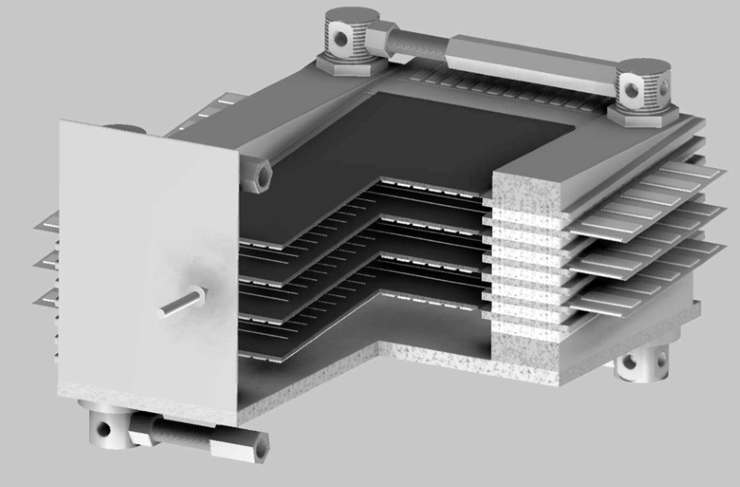FLNP JINR developed highly efficient detector of thermal and cold neutrons
Media, 17 July 2023
Scientists of the Laboratory of Neutron Physics JINR have developed a new position-sensitive gas detector of thermal and cold neutrons. According to the inventors, the detector surpasses in its characteristics similar detectors used in European scientific centres. Scientists have improved the construction of the high-speed narrow-gap gas ionization chamber developed in 1998 at the Laboratory of Nuclear Problems. They used aluminium foil stretched into a flat surface and coated with a boron carbide neutron converter as a cathode. This detector is designed to be used at various facilities applying the neutron scattering method to study the structure of condensed matter. JINR received patent No. 2797497 for the invention of thermal and cold neutron detector on 6 June 2023.
The Multi-foil detector, as its inventors call it, developed at JINR is in fact the improved European detector Multi-Blade based on the inclined geometry principle, that is the orientation of the surface of the convert layer at a small angle to the neutron beam. It increases the efficiency of their registration. When manufacturing the Multi-foil detector, the boron carbide converter can be applied not only to aluminum foil with a thickness of 50 microns, but also to polymer film made of radiation-resistant material with a thickness of 20 microns. Much thinner substrates than those of the Multi-blade detector plates provide the new detector with a significant advantage.
One of the inventors of the detector, leading engineer of the Scientific and Experimental Department of the IBR-2 Spectrometer Complex of FLNP JINR Alexander Kolesnikov commented on the operation principles of the device, “Aluminium foil or polymer film as a substrate, which is a cathode, is adjusted to the holders from two opposite sides and stretched into a plane. Anode wires are placed between two substrates that form an anode plate in the stretched state. Remote inserts placed between anode holders and substrate holders set the width of the chamber and the distance to anode and cathode. Wedge-shaped inserts set the angle α of the neutron incidence on the converter surface from 1 to 5 degrees. Anode holders, substrate holders, remote and wedge-shaped inserts are pressed against each other by fasteners, which are made in such a way as to adjust the stretching degree of substrates and anode wires.”
 Position-sensitive gas detector of thermal and cold neutrons
Position-sensitive gas detector of thermal and cold neutrons
According to the developers, such an engineering solution increases the efficiency of neutron registration thanks to the possibility to decrease the angle of neutron incidence. “It is practically impossible to make an angle of less than 5 degrees in the designs of our Western partners due to the use of a relatively thick substrate lying freely, ensuring high flatness of which is impossible over a large area. In our case, when using foil or film stretched into a flat surface, this angle may be 2 degrees and even less. Based on the calculations, it increases the efficiency of registration of thermal neutrons with a wave length of 1,8 angstrom up to 67 per cent,” Alexander Kolesnikov noted. The use of well-studied at DLNP JINR narrow-band chambers in the construction of the Multi-foil detector provides high loading capacity, high space and time resolution.
FLNP is currently finishing the creation of the experimental site for the development and production of thermal neutron detectors based on the boron carbide converter. The received patent starts the development of new neutron detectors of the world-level. The FLNP JINR experimental site will manufacture modern position-sensitive detectors, as well as detectors of other types, such as counters, beam monitors, etc. The site will be commissioned at the end of this year and will provide neutron scattering facilities with modern detectors both at the IBR-2 Reactor and other research centres around the world.